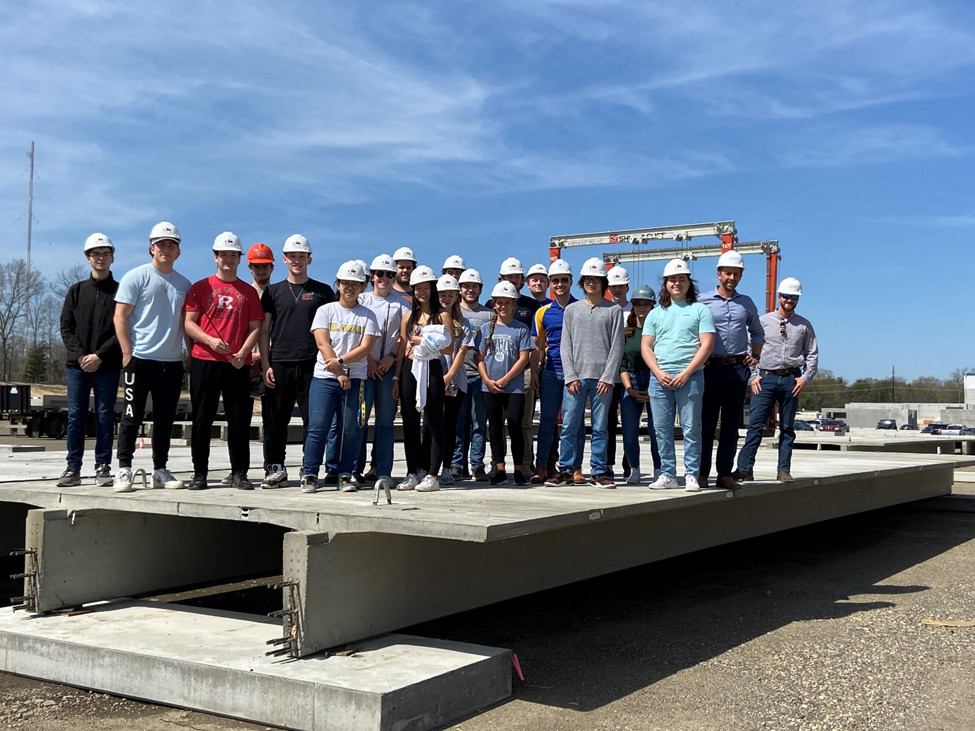Bridging the Gap: Fostering Real-World Experiences in Prestressed Concrete Design
By Associate Professor Jovan Tatar, University of Delaware
As a professor at the University of Delaware, I have had the privilege of teaching Prestressed Concrete Design for several years now. Over time, I've come to recognize the importance of bridging the gap between engineering education and industry practice. I want to share the remarkable journey we've embarked on in collaboration with the PCI Foundation and how it has enriched the learning experiences of our students while strengthening ties with the precast industry.
Concrete is one of the fundamental building blocks of our modern world, quite literally. From towering skyscrapers to elaborate bridges and other infrastructure, it plays a pivotal role in shaping our built environment. Understanding the intricacies of structural concrete design is not just a theoretical exercise; it's an essential skill that civil engineering students must master to contribute effectively to our society.
However, the challenge often faced by engineering educators is ensuring that students graduate with not only theoretical knowledge but also practical skills that can be seamlessly applied in real-world scenarios. This is where our partnership with the PCI Foundation becomes crucial.

Tatar’s class during a plant visit to Northeast Precast, Vineland, New Jersey. Photo: Dawn Decker
The PCI Foundation has been a driving force behind our efforts to provide students with hands-on experience in prestressed concrete design. Through this collaboration, our students have the unique opportunity to work on real-world design projects mentored by industry professionals. This practical exposure has proven invaluable in preparing our students for the challenges they will face in their engineering careers.
Here are a few key reasons why I believe bridging the gap between engineering education and industry practice is so important:
- Relevance: By working on real projects, students gain a deeper understanding of the design process. They see how their classroom knowledge directly applies to the complexities and constraints of actual projects.
- Practical Skills: Theoretical knowledge is vital, but it's the practical skills that truly empower our graduates. Through industry collaborations, students learn how to navigate design software, interpret building codes, and address real-world engineering challenges.
- Networking: Building relationships with industry professionals opens doors for our students. It fosters networking opportunities that can lead to internships, job placements, and a support system as they begin their careers.
- Innovation: Exposure to real-world projects often inspires students to think creatively. They start to question existing practices and explore new, sustainable, and efficient ways of designing and building with precast.
- Confidence: Knowing that they've successfully contributed to real projects during their academic journey boosts students' confidence in their abilities and prepares them for the responsibilities they'll assume as professional engineers.
In our Prestressed Concrete Design course, we have had the privilege of collaborating with esteemed industry partners such as Shockey Precast, Tindall Corporation, and PennStress. Our students have taken on the challenge of designing precast parking garages, stadiums, and residential buildings, working hand in hand with these industry leaders.
The impact has been profound. Not only have our students gained a deeper understanding of precast/prestressed concrete design, but they've also developed essential professional skills. They've learned to present their project designs, communicate with industry experts, and collaborate as part of a team. These experiences set them on a trajectory of success as they enter the workforce.
In conclusion, bridging the gap between engineering education and practice through collaborations with industry is more than just a pedagogical choice; it's a necessity! It equips students with the skills, confidence, and real-world experiences they need to thrive in the dynamic field of structural engineering. I am grateful to the PCI Foundation for their unwavering support, and I encourage other universities and institutions to explore similar partnerships to enrich the education and prospects of their engineering students. Together, we can build a stronger, more capable generation of precast industry professionals who will shape the future of our built environment.
A Recent Highlight
Two of my students – Ajay Baniya and KJ Olsen – competed in this year’s Project Precast at the PCI convention, and both won prizes. The competition allows students to apply what they’ve learned in the classroom, interact with architecture and construction management students from around the country, and receive hands-on mentoring to design and present a project concept.

Ajay Baniya, University of Delaware, front and left, with the winning Project Precast team and Metromont mentors and sponsor. Photo: Dawn Decker
Tatar joined the University of Delaware in 2018 after two years as an Assistant Professor at the University of Louisiana at Lafayette. He holds a doctoral degree and master’s degree in civil engineering from the University of Florida and a bachelor’s degree in civil engineering from the University of Montenegro.
Want to learn more about guest lectures, plant tours, and other educational materials from PCI Mid-Atlantic? Reach out!
© 2023 Precast/Prestressed Concrete Institute Mid-Atlantic Chapter

.jpg)



